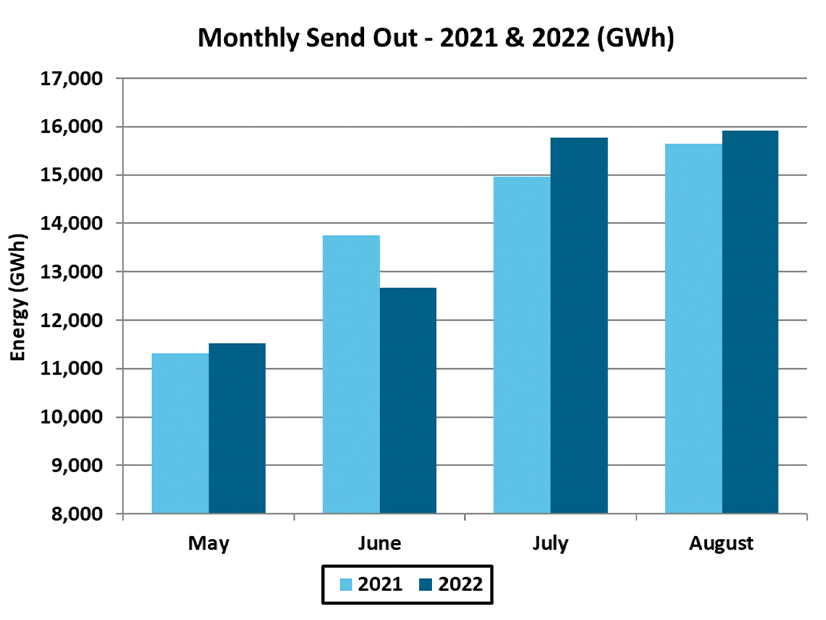NYISO on Thursday presented the Operating Committee with its proposed comments to a FERC rulemaking on interconnection queues, the impacts that above-average summer temperatures had on the grid and the results for four solar units that were part of the 2022-01 Expedited Deliverability Study (EDS).
Comments on NOPR
Thinh Nguyen shared NYISO’s proposed comments to FERC’s Notice of Proposed Rulemaking (RM22-14), which seeks to address interconnection queue backlogs as more renewables enter service.
NYISO broadly concurred with FERC on what it said would be the “most significant and comprehensive set of proposed revisions” to interconnection procedures since FERC Order 2003, recognizing that changes are critical.
But the ISO is concerned that certain provisions — such as allowing interconnection customers to request an informational study before submitting a request — would lengthen the time to complete an interconnection study, limit its abilities to operate efficiently and hamper FERC’s intentions. Other proposed studies would “run counter” to FERC’s goal of speeding up queue processes because they would require an additional “workload” that could be better allocated toward unclogging the queue itself, Nguyen said.
NYISO also believes that FERC’s proposal to fine transmission owners $500/day for study delays is unlikely to incent faster interconnection processes and, instead, would result in costs being passed down to customers.
Nguyen said that other provisions in the NOPR, such as increased financial commitments, would disincentivize speculative projects while encouraging transmission developers to “work in a faster more efficient manner,” such as by providing them with information around queue decision-making processes or creating rules that enable them to co-locate their projects.
NYISO also plans to support the proposed “first-ready, first-served” construct and allowing projects to be studied at the same time in clusters.
Nguyen said that FERC’s intentions are solid, but the ISO’s comments will continue to emphasize that the commission must allow it operational flexibility in certain instances. Grid operators should be able to have the “flexibility to tailor whatever the proposal is according to their region,” as each has “different market rules,” he said.
Expedited Deliverability Study Results
NYISO released results from the 2022-01 EDS, which examined the feasibility of four solar projects and found that all of them passed the relevant tests.
 Four solar EDS 2022-01 projects successfully passed all relevant tests. | NYISO
Four solar EDS 2022-01 projects successfully passed all relevant tests. | NYISO
The projects in the study included:
- Highbanks Solar (Zone B)
- Clear View Solar (Zone C)
- Somers Solar (Zone F)
- Stone Mill Solar (Zone F)
The units were studied to determine whether they are deliverable as currently proposed without the need for system delivery updates.
EDS comprises several deliverability tests, such as the Highway Interface Transfer Capability “No Harm” Test, which collectively identify potential need for transmission or interconnection upgrades. Projects seeking to join an EDS must meet several eligibility requirements, such as providing notice to NYISO by the study’s start date, satisfying data submission requirements and, in certain cases, completing a Class Year study.
The 2022-01 EDS is expected to be completed Oct. 13, and the next study will start on the first business day 30 calendar days from the completion of the current one.
Summer Highs Test System
Heat waves, shifting load peaks because of behind-the-meter solar and increased use of utility demand response programs characterized New York’s 2022 summer, according to NYISO Vice President Aaron Markham.
Summer heat waves during July 17-24 and Aug. 3-9 led to peak loads surpassing 30 GW, prompting regulators and political leaders to issue warnings that urged customers to conserve electricity to avoid blackouts.
These warnings lowered peak loads, while regional coordination calls ensured that energy supplies were readily available in case of resource inadequacy, resulting in no emergency actions being taken throughout the summer, Markham said.
Meanwhile, increasing installation of BTM solar is resulting in daily peak loads shifting to later in the afternoon, which has meant that on certain days, peak load has remained constant over several hours. This changing dynamic is something the ISO will “keep an eye on” as BTM solar is “integrated more and more” and starts to encompass a larger proportion of the energy mix, according to Markham.
Despite higher-than-average temperatures and system peak loads, the total load over the summer was lower than projections because of deficits in June and July.
NYISO Releases the Outlook
NYISO also announced on Thursday the release of its completed System & Resource Outlook. A draft of the report had been presented last month to the Business Issues Committee. (See NYISO 20-Year Forecast Highlights Generation, Tx Hurdles to Climate Goals.)
The inaugural report, which forecasts system needs for a 20-year period, predicts an unprecedented need for more than 95 GW of new zero-emission resources by 2040 and 20 GW within the next seven years to meet the goals of the New York Climate Leadership and Community Protection Act.
Additionally, the installation rate of these added resources must increase significantly, while dispatchable emission-free resources must be developed and added to the system to reliably serve demand when intermittent generation is unavailable.
The outlook, which will be updated every two years, will get increasingly more detailed after each iteration, according to NYISO.



